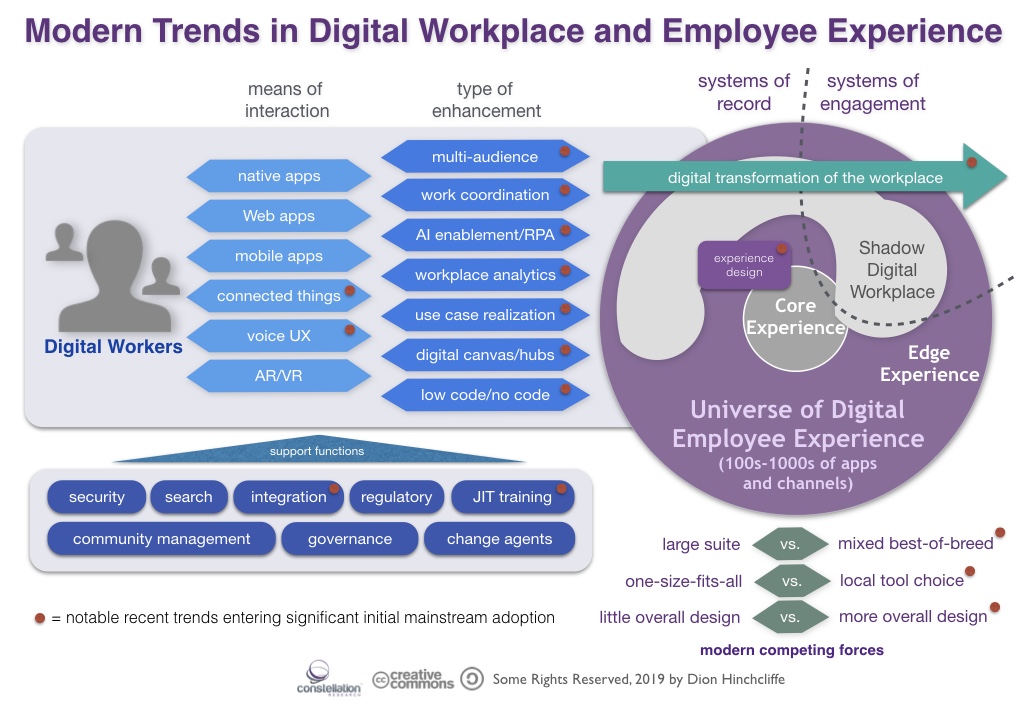How should we design the modern employee experience? Some form of this query is perhaps the leading question I get today from IT and HR teams as they grapple with the sweeping forces of technological and societal change happening all around us.
Many questions abound: Why isn’t tool adoption happening faster? What can I do to maximize the impact of existing technologies and investments? What is the design focus of the digital workplace today? How can I measure my employee experience? Is the intranet still relevant? What do I do about Shadow IT? What about the super suites like Office365 and Google Suite? Are they inevitable or should we pick and choose? How do I design and integrate all of this into a more cohesive whole? Is low-code, no-code an end-user technology that I should be rolling out? Where does artificial intelligence (AI) fit into an overall digital workplace strategy? What else am I missing to stay ahead of the curve?
These and many other issues are top of mind in digital workplace teams this year. Such teams are a relatively new construct I’ve only seen emerging in the last half-decade or so. Created well, they can bring order to the complexity and confusion that often reigns in the overall digital employee experience today, and they tend to be found more often in larger, well-funded IT organizations. The responsibility of such groups, which in their best form are integrated into a center or network of excellence with HR and other groups, has become profound as it drives forward employee engagement with technology, improves worker effectiveness, and even contributes directly to the competitive stance of the organization as a whole.
To help digital workplace teams in IT as well as employee experience specialists in HR groups, I’ve assembled a brand new report containing what I see are the top trends coming together today that must be addressed and/or are becoming unignorable bottom-up issues in these vital domains for workers, especially knowledge workers that drive the growth in today’s global economy.
The reality on the ground is that support groups that enable workers with technology are often simply overwhelmed and underbudgeted with a deep bench of legacy technology to manage, too many new systems, applications, and digital channels that need to be deployed, and are often well behind where they want to be to become a best-in-class organization, which has become crucial in an increasingly winner-takes-all digital operating environment.
Titled Modern Digital Workplace Trends and Emerging Practices, this just-published report aims to bring together a single view of the major issues and concerns that digital workplace and employee experience practitioners must face successfully to help their organizations thrive in the digital age. I believe this view, shown in summary in the visual above, can form a blueprint and checklist for how practitioners can not only succeed, but get ahead in their efforts today.
Modern Digital Workplace Issues and Key Topics
Here is a summary of the issues and topics addressed in this report, highlighted in red dots in the visual above:
- Users caught between best-of-breed vs. large digital workplace suites.
- Local tool choice trumps one-size-fits-all.
- Design thinking and principles guide the overall realization of the digital workplace.
- Building employee skills with just-in-time digital workplace training.
- Employee experiences move to integrated digital workplaces.
- Every employee is becoming a citizen developer.
- Digital workplace hubs unite experiences.
- Solutions are increasingly shaped by use cases and business processes.
- Design and measurement take advantage of workplace analytics.
- The digital workplace is extended and automated by intelligent technologies.
- Work is more deeply digitized and coordinated.
- The digital workplace experience extends to more audiences.
- Experience design drives a more effective and relevant digital workplace.
- The employee experience is connected to the devices that drive the business.
- Employee experiences will be guided by voice.
- Digital transformation of the workplace gets more investment and organization.
Those using this report for their digital workplace and employee experience planning are recommended to adapt these ideas and trends to their organization. While I’ve attempted to cull the cumulative experience from dozens of digital workplace initiatives and projects that I’ve had the priveldge to lead, work on, or review, almost all strategies, concepts, and technologies must be shaped for a particular organizations’ culture, inclinations, and sensitivities.
Please contact me at [email protected] to discuss how these issues and topics can best be addressed in your organization.
New Report: Modern Digital Workplace Trends and Emerging Practices



